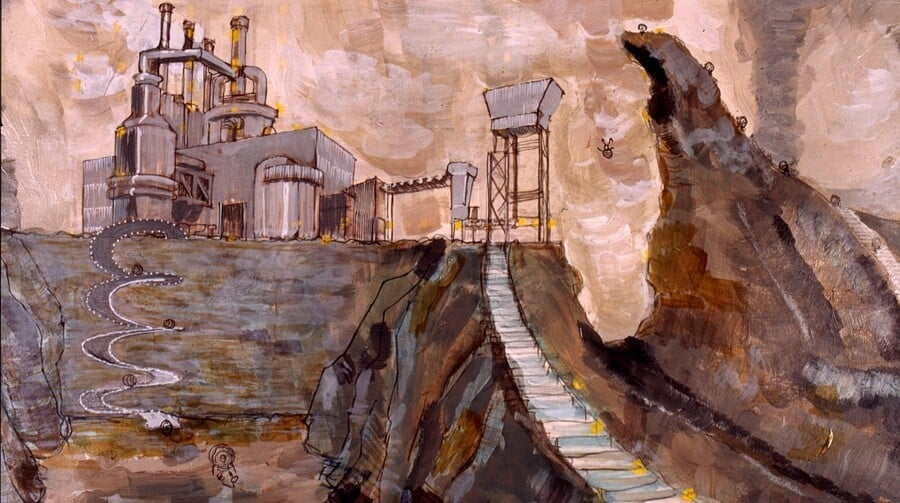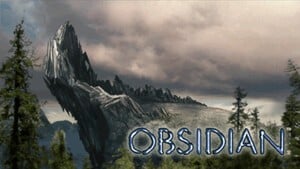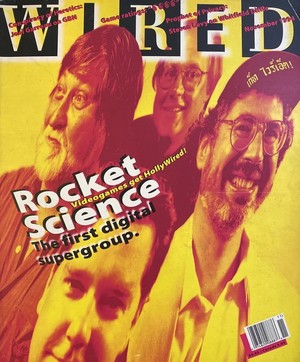
When the developer Rocket Science Games released the adventure game Obsidian for Windows and Mac computers back in 1997, it needed a miracle.
After years of disappointing games, such as Cadillacs and Dinosaurs: The Second Cataclysm, Wingnuts: Battle in the Sky, and Loadstar: The Legend of Tully Bodine, the company was beginning to run out of money and the initial enthusiasm that the media had shown towards the studio was starting to wane.
It needed Obsidian to "go nuclear" if it was to reverse its fortunes but despite strong reviews from publications like PC Gamer (US) and Gamespot and a heap of marketing (including a trailer from Rocky Morton, the co-creator of Max Headroom and co-director of the Super Mario Bros. film), it ended up being another big-budget failure to add to the company's growing pile and eventually vanished into obscurity, taking Rocket Science along with it.

Normally, this would be where you'd expect the story of a game like Obsidian to end, but remarkably, earlier this year, it became playable again after more than two decades of being abandonware.
So, in order to mark this occasion, we thought it would be a great time to chat with the Rocket Science producer Matthew Fassberg to find out more about the ambitious studio, Obsidian's tricky development, and how this surprising rerelease came to be. This took us back to 1993, which is when the company Rocket Science was initially formed.
At the time, Rocket Science was a hot new start-up within the Bay Area, making a name for itself by hiring the best talent it could find in film, games, music, & television. Matthew Fassberg, for example, came from a background in TV, having worked on channels like MTV and Comedy Central. Meanwhile, some of Rocket Science's other hires included Alex Laurant (who went on to work at ILM), Jay Schuster who later worked at Pixar, the Hollywood visual artists Mark Sullivan and Rich Cohen, and former Lucasfilm Games designers David Fox and Brian Moriarty.
"Even on the engineering side, our head of engineering invented Quicktime," Fassberg adds. "And one of the heads of the company Peter Barrett invented CinePak, which was the first video compression software that was available. Elon Musk [even] worked at Rocket Science for an hour in IT, or in programming (I can’t quite remember)."

Rocket Science was absolutely stacked with top-tier talent and its CEO Steve Blank hoped that this approach would generate some good publicity for the company, which it quickly did. The publication Wired featured the company on its front cover and called it "the first digital supergroup", while trade magazines couldn't help but shine a spotlight on the Rocket Science story. The amount of positive press felt like a blessing at first, but eventually turned into somewhat of a curse.
Writing on his blog in 2019, Blank stated, "Our “Hollywood meets Silicon Valley” story played great in Silicon Valley, they ate it up in Hollywood, and the business press tripped over themselves to talk to us. The story had universal appeal, and we spun the tale to keep the buzz going. It worked. Judging by the ink we had gotten, we were the hottest company in the game business, with stories in Fortune, Forbes, Variety, The Hollywood Reporter, and the cover of Wired magazine. Yet we hadn’t shipped a single product. While it felt wonderful at the time, this was a very bad idea."
When Rocket Science released its first two games in 1994 for the Sega CD — the on-rail shooters Loadstar and Cadillacs and Dinosaurs: The Second Cataclysm) — the reaction from the media and players was far from adoring. As Rocket Science personnel later admitted, these games were rushed to get some products out on the market fast and didn't necessarily perform as well as the company had hoped. Others inside the company believed they were far too simple compared to what the studio had been promising in the media, and that they failed to capitalize on the hype.
Fassberg tells Time Extension, "In the first round of games from Rocket Science, the emphasis on making it look good meant that we kept simplifying the game. Cadillacs and Dinosaur was one game and Loadstar was the other; they came out at the same time and both game designers David Fox and Brian Moriarty were complaining, ‘You’re killing my game design here.’ We really took a hit in the first round of publicity because we so oversold what we were doing compared to what we delivered because we cut down on the gameplay too much."
In 1995, the company reflected on these failures in a rather candid conversation with Wired, where the spokesperson Anna Caldwell and executive vice president Peter Barrett revealed that it had decided to stop focusing primarily on action games and try for something more ambitious instead. These plans included the development of a new game called Obsidian for SegaSoft, described by Wired at the time as "a Myst-like exploration and idea game".
"Myst came out and went nuclear," explains Fassberg, "And the artists Mark Sullivan and Rich Cohen, who had come from the Hollywood side of this, started designing some characters and some scenes. They proposed a game and we loved the visuals, but when we asked them about the gameplay, they weren’t serious gamers. They weren’t even casual gamers. And they just didn’t have a great story or game behind their visuals."

Seeing the potential in Sullivan and Cohen's art, a team at Rocket Science continued trying to come up with a better design that they could use to bring the game together, when one day, an individual named Adam Wolff (who had joined the company as a general helper/IT person) stepped up and offered to help out.
"He was in the room with Mark, Rich, and Me, and a few others," remembers Fassberg. "And after the meeting, he approached me and said, ‘You know Matt, I can design a game. I’m into gaming. I love their visuals. Give me a chance!’"
Rather than shoot down the aspiring designer, Fassberg gave Wolff the opportunity to prove himself by bringing him on board the project as the interactive story writer and designer. He would later be joined by Scott Kim who was responsible for designing the game's visual puzzles, and the Hollywood screenwriter Howard Cushnir who penned the game's script.
"Adam was super smart and had a lot of ideas," says Fassberg. "And Scott Kim had a book called Inversions and was very smart visually. So Adam was combining logic puzzles and visual puzzles, and then Howard Cushnir, the writer, was figuring out places in the story where a puzzle could take place while still pushing the story ahead."

The story the team created for Obsidian takes place in 2066 and follows two scientists named Lilah and Max who have just created an AI-controlled satellite named Ceres capable of repairing the ozone layer and removing air pollution with the aid of nanobots. Following its successful launch, the pair go on a camping trip to an area they believe to have been positively impacted by their work but begin to notice a glassy black structure growing on a nearby mountain. Max enters the mysterious structure and goes missing, and it eventually falls to Lilah to go in after him and rescue her partner from a now out-of-control Ceres.
Even to this day, Obsidian manages to be a thought-provoking exploration of topics such as science, dreams, and A.I., with players taking control of Lilah and guiding her through various worlds where she'll defy gravity, manipulate nature and machinery, and reason with her creation about the future of humanity.
"I think we thought dreams were a perfect place to use because anything can go on in dreams," says Fassberg. "It really opens the book to anything you want to make, in terms of characters or monsters or environments. We all know we’ve had weird dreams: we’re flying or we’re swimming underwater for hours, we’re talking to people who aren’t alive, or whatever it is. Using dreams became a great premise upon which to use almost any art that we got or made. An artist would come in and say, ‘Oh, hey, I’ve done a thing with clouds and rings going through them’ and we would say ‘Oh, let’s make a puzzle about that!’ So it really let us just be very open to different forms of art and types of puzzles that people could propose because it wasn’t locked into one specific, realistic setting."
In total, Obsidian took two years to finish, and after it was completed hopes at the studio were high. Yet, despite the Myst-like adventure receiving strong reviews from critics, it ended up bombing commercially. So, as a result of this, it became the last game Rocket Science ever released, with the company going out of business not long after.
"Obsidian was the last thing Rocket Science did," Fassberg tells us. "I mean, we closed the door on that game. I know we had basically shut down the company, but we were being asked to translate it so I was part of a small team that was making the translated games. So Obsidian was the last thing we did. We had spent a lot of our money and I just think, for reasons that don’t have to do with the quality of the game, I’m not sure that a real push was made to sell it by Segasoft, who may have been having other problems at the time. It just came late in the lifespan of the company. We got a lot of great press. We thought this was going to go nuclear. And then it didn’t."
Over time, players pretty much forgot about Obsidian as it became more and more difficult to run the title on modern hardware. Then, out of nowhere, earlier this year, ScummVM revealed that it had added Obsidian to its list of compatible games, followed shortly after by an announcement that the Jordan Freeman Group and the company Call Your Vegetables were planning to republish the game on Steam and Zoom. This is now possible thanks to the its new publishers obtaining the rights to reissue from its original developers, much as they had done with other Sega Soft titles in the past like The Space Bar, Plane Crazy, and Emperor of the Fading Suns,
Speaking about the rerelease, Fassberg doesn't quite know how the game will go down with players in 2023, but is happy people are now getting another chance to discover it.
He tells Time Extension, "I’m curious what humans think of it now and what people are looking for for entertainment. Are people going to enjoy this? I’m deeply curious. [...] A lot of work went into that game, man. We practically killed ourselves over those two years."
As mentioned, if you want to check out Obsidian, you can grab it now on either Steam or Zoom.

